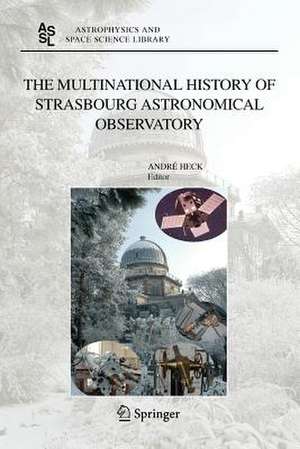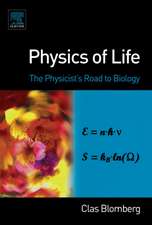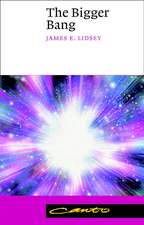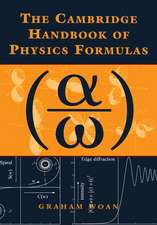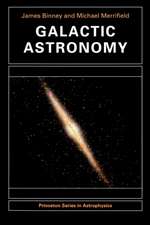The Multinational History of Strasbourg Astronomical Observatory: Astrophysics and Space Science Library, cartea 330
Editat de Andre Hecken Limba Engleză Paperback – 22 oct 2010
Most of the documents circulating on the history of the Observatory and on related matters have however been so far poorly referenced, if at all. This made necessary the compilation of a volume such as this one, offering fully-documented historical facts and references on the first decades of the Observatory history, authored by both French and German specialists.
The experts contributing to this book have done their best to write in a way understandable to readers not necessarily hyperspecialized in astronomy nor in the details of European history.
Several appendices conclude the book: lists of council members and of Observatory scientific personnel, as well as a compendium of the institutional publications until the year 2000.
Din seria Astrophysics and Space Science Library
- 24%
 Preț: 799.08 lei
Preț: 799.08 lei - 15%
 Preț: 647.92 lei
Preț: 647.92 lei - 18%
 Preț: 983.81 lei
Preț: 983.81 lei - 18%
 Preț: 790.28 lei
Preț: 790.28 lei -
 Preț: 359.85 lei
Preț: 359.85 lei -
 Preț: 389.70 lei
Preț: 389.70 lei - 20%
 Preț: 691.13 lei
Preț: 691.13 lei - 20%
 Preț: 816.17 lei
Preț: 816.17 lei - 18%
 Preț: 1011.27 lei
Preț: 1011.27 lei -
 Preț: 402.56 lei
Preț: 402.56 lei - 15%
 Preț: 664.93 lei
Preț: 664.93 lei -
 Preț: 398.15 lei
Preț: 398.15 lei - 18%
 Preț: 954.77 lei
Preț: 954.77 lei -
 Preț: 411.04 lei
Preț: 411.04 lei - 18%
 Preț: 1225.31 lei
Preț: 1225.31 lei - 18%
 Preț: 1843.29 lei
Preț: 1843.29 lei -
 Preț: 393.13 lei
Preț: 393.13 lei -
 Preț: 400.26 lei
Preț: 400.26 lei - 18%
 Preț: 953.82 lei
Preț: 953.82 lei - 18%
 Preț: 960.61 lei
Preț: 960.61 lei -
 Preț: 398.35 lei
Preț: 398.35 lei -
 Preț: 390.84 lei
Preț: 390.84 lei -
 Preț: 413.76 lei
Preț: 413.76 lei -
 Preț: 416.64 lei
Preț: 416.64 lei - 18%
 Preț: 947.67 lei
Preț: 947.67 lei -
 Preț: 404.51 lei
Preț: 404.51 lei - 18%
 Preț: 956.50 lei
Preț: 956.50 lei -
 Preț: 403.75 lei
Preț: 403.75 lei - 18%
 Preț: 1229.40 lei
Preț: 1229.40 lei - 18%
 Preț: 1224.99 lei
Preț: 1224.99 lei -
 Preț: 404.29 lei
Preț: 404.29 lei - 15%
 Preț: 654.77 lei
Preț: 654.77 lei - 18%
 Preț: 1248.20 lei
Preț: 1248.20 lei - 18%
 Preț: 955.25 lei
Preț: 955.25 lei - 18%
 Preț: 1846.28 lei
Preț: 1846.28 lei - 18%
 Preț: 1233.06 lei
Preț: 1233.06 lei - 18%
 Preț: 1234.77 lei
Preț: 1234.77 lei
Preț: 641.85 lei
Preț vechi: 755.13 lei
-15% Nou
Puncte Express: 963
Preț estimativ în valută:
122.82€ • 128.56$ • 102.22£
122.82€ • 128.56$ • 102.22£
Carte tipărită la comandă
Livrare economică 31 martie-14 aprilie
Preluare comenzi: 021 569.72.76
Specificații
ISBN-13: 9789048169184
ISBN-10: 9048169186
Pagini: 328
Ilustrații: VIII, 318 p.
Dimensiuni: 160 x 240 x 17 mm
Greutate: 0.46 kg
Ediția:Softcover reprint of hardcover 1st ed. 2005
Editura: SPRINGER NETHERLANDS
Colecția Springer
Seria Astrophysics and Space Science Library
Locul publicării:Dordrecht, Netherlands
ISBN-10: 9048169186
Pagini: 328
Ilustrații: VIII, 318 p.
Dimensiuni: 160 x 240 x 17 mm
Greutate: 0.46 kg
Ediția:Softcover reprint of hardcover 1st ed. 2005
Editura: SPRINGER NETHERLANDS
Colecția Springer
Seria Astrophysics and Space Science Library
Locul publicării:Dordrecht, Netherlands
Public țintă
ResearchCuprins
Strasbourg Astronomical Observatory and its Multinational History.- Strasbourg Observatory in German Times.- The Observatory of the Emperor Wilhelm University: the People Behind the Documents.- Strasbourg Observatory in World War II.- Strasbourg Observatory: A Breeding Place for French Astronomical Instrumentation in the 20TH Century.- Walter F. Wislicenus and Modern Astronomical Bibliography.- The Nebular Research of Carl Wirtz.- Paul Muller (1910–2000).- Vistas into the CDS Genesis.- The Stellar Data Center: Origins and Early Beginnings (1972–1974).- The Hipparcos Project at Strasbourg Observatory.- Strasbourg Observatory and the Astronomische Gesellschaft.- Strasbourg Observatory and Astronomical Events in the Regional Press in the Early 20TH Century.- The Coronelli Globe of Strasbourg Observatory.- Strasbourg Green Rays.- Strasbourg Observatory Council Members.- CDS Council Members.- Strasbourg Observatory Scientific Personnel (From Foundation to About Year 2000).- Strasbourg Observatory Institutional Publications.
Recenzii
"Most of the documents circulating on the history of the Observatory and on related matters have however been so far very poorly referenced, if at all. This rendered necessary the compilation of a volume such as this one, offering fully-documented historical facts and references regarding the first decades of the Observatory's history, authored by both French and German specialists."
"This is the first and only work that gives such an extensive overview of the position of that important institute in teh development of European science." (ORION, No330, October 5/2005)
"Un livre des plus interessants, a recommander." - Roger Ferlet , l'Astronomie - Novembre 2006 - vol. 120
"In this well-documented book, André Heck and his fourteen co-authors are retracing a unique and exemplary chapter of astronomical history, that of the Strasbourg Observatory, in heart of Alsace." "This book is altogether a fine survey of a bipolar observatory, as described by André Heck in the first chapter of his book." - Jean-Claude Pecker, The Observatory, Vol.127, No.1198 June 2007
"This is the first and only work that gives such an extensive overview of the position of that important institute in teh development of European science." (ORION, No330, October 5/2005)
"Un livre des plus interessants, a recommander." - Roger Ferlet , l'Astronomie - Novembre 2006 - vol. 120
"In this well-documented book, André Heck and his fourteen co-authors are retracing a unique and exemplary chapter of astronomical history, that of the Strasbourg Observatory, in heart of Alsace." "This book is altogether a fine survey of a bipolar observatory, as described by André Heck in the first chapter of his book." - Jean-Claude Pecker, The Observatory, Vol.127, No.1198 June 2007
Textul de pe ultima copertă
Strasbourg Astronomical Observatory is quite an interesting place for historians: several changes of nationality between France and Germany, high-profile scientists having been based there, big projects born or installed in its walls, and so on.
Most of the documents circulating on the history of the Observatory and on related matters have however been so far poorly referenced, if at all. This made necessary the compilation of a volume such as this one, offering fully-documented historical facts and references on the first decades of the Observatory history, authored by both French and German specialists.
The experts contributing to this book have done their best to write in a way understandable to readers not necessarily hyperspecialized in astronomy nor in the details of European history.
After an introductory chapter by the Editor, contributions by Wolfschmidt and by Duerbeck respectively deal extensively with the German periods and review people and instrumentation, while another paper by Duerbeck is more specifically devoted to World War II times. A subsequent chapter by Débarbat describes the development of instrumentation at Strasbourg Observatory during the French period between World Wars. Several contributions are devoted to specific astronomers such as Wislicenus (Duerbeck), Wirtz (Duerbeck & Seitter), and Muller (Bacchus).
Two chapters by Heck and Jung deal with the genesis and the first years of the Stellar Data Center (CDS) installed at Strasbourg Observatory, while Kovalevsky recalls that the Hipparcos space experiment was born there.
Seggewiss reminds the links of the Observatory with the Astronomische Gesellschaft, starting with the inauguration of the place. Bodenmuller & Heck discuss the visibility of the Observatory in the regional press around the beginning of the 20th century and two notes by Heck analyze respectively the Coronelli globe of the observatory and Danjon & Rougier’s first spectroscopicstudies of the green flash from Strasbourg.
Several appendices conclude the book: lists of council members and of Observatory scientific personnel, as well as a compendium of the institutional publications until Year 2000.
This book will be most usefully read by historians, researchers, teachers, librarians as well as by students in astronomy and sociologists of science.
Most of the documents circulating on the history of the Observatory and on related matters have however been so far poorly referenced, if at all. This made necessary the compilation of a volume such as this one, offering fully-documented historical facts and references on the first decades of the Observatory history, authored by both French and German specialists.
The experts contributing to this book have done their best to write in a way understandable to readers not necessarily hyperspecialized in astronomy nor in the details of European history.
After an introductory chapter by the Editor, contributions by Wolfschmidt and by Duerbeck respectively deal extensively with the German periods and review people and instrumentation, while another paper by Duerbeck is more specifically devoted to World War II times. A subsequent chapter by Débarbat describes the development of instrumentation at Strasbourg Observatory during the French period between World Wars. Several contributions are devoted to specific astronomers such as Wislicenus (Duerbeck), Wirtz (Duerbeck & Seitter), and Muller (Bacchus).
Two chapters by Heck and Jung deal with the genesis and the first years of the Stellar Data Center (CDS) installed at Strasbourg Observatory, while Kovalevsky recalls that the Hipparcos space experiment was born there.
Seggewiss reminds the links of the Observatory with the Astronomische Gesellschaft, starting with the inauguration of the place. Bodenmuller & Heck discuss the visibility of the Observatory in the regional press around the beginning of the 20th century and two notes by Heck analyze respectively the Coronelli globe of the observatory and Danjon & Rougier’s first spectroscopicstudies of the green flash from Strasbourg.
Several appendices conclude the book: lists of council members and of Observatory scientific personnel, as well as a compendium of the institutional publications until Year 2000.
This book will be most usefully read by historians, researchers, teachers, librarians as well as by students in astronomy and sociologists of science.
